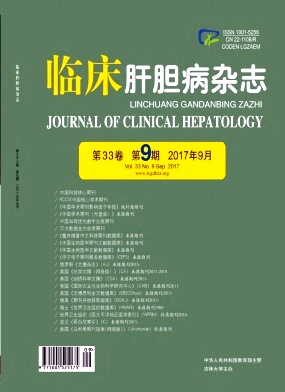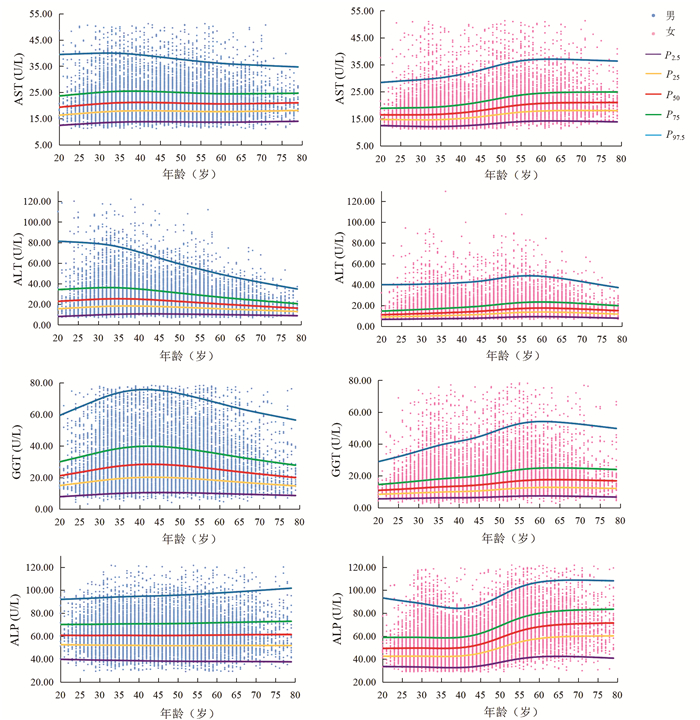|
[1]KEW MC.Hepatocellular carcinoma in developing countries:prevention, diagnosis and treatment[J].World J Hepatol, 2012, 4 (3) :99-104.
|
|
[2]FORNER A, LLOVET JM, BRUIX J.Hepatocellular carcinoma[J]Lancet, 2012, 379 (9822) :1245-1255.
|
|
[3]ZHENG SS, YU J, ZHANG W.Current development of liver transplantation in China[J].J Clin Hepatol, 2014, 30 (1) :2-4. (in Chinese) 郑树森, 俞军, 张武.肝移植在中国的发展现状[J].临床肝胆病杂志, 2014, 30 (1) :2-4.
|
|
[4]PFIFFER TE, SEEHOFER D, NICOLAOU A, et al.Recurrent hepatocellular carcinoma in liver transplant recipients:parameters affecting time to recurrence, treatment options and survival in the sorafenib era[J].Tumori, 2011, 97 (4) :436-441.
|
|
[5]BYAM J, RENZ J, MILLIS JM.Liver transplantation for hepatocellular carcinoma[J].Hepatobiliary Surg Nutr, 2013, 2 (1) :22-30.
|
|
[6]WANG Z, ZHOU J.Combined modality therapy for recurrent hepatocellular carcinoma following liver transplantation[J].Chin JHepatol, 2013, 21 (5) :324-325. (in Chinese) 王征, 周俭.肝癌肝移植术后的综合治疗[J].中华肝脏病杂志, 2013, 21 (5) :324-325.
|
|
[7]Chinese Society of Liver Cancer, Chinese Anti-Cancer Association.Diagnostic criteria for primary liver cancer[J].Chin J Hepatol, 2000, 8 (3) :135. (in Chinese) 中国抗癌协会肝癌专业委员会.原发性肝癌诊断标准[J].中华肝脏病杂志, 2000, 8 (3) :135.
|
|
[8]FAN J, ZHOU J, XU Y, et al.Indication of liver transplantation for hepatocellular carcinoma:Shanghai Fudan Criteria[J].Natl Med JChina, 2006, 18 (3) :1227-1231. (in Chinese) 樊嘉, 周俭, 徐泱, 等.肝癌肝移植适应证的选择:上海复旦标准[J].中华医学杂志, 2006, 18 (3) :1227-1231.
|
|
[9]RAHIMI RS, TROTTER JF.Liver transplantation for hepatocellular carcinoma:outcomes and treatment options for recurrence[J].Ann Gastroenterol, 2015, 28 (3) :323-330.
|
|
[10]LI T, SHEN C, XIE JJ, et al.Effects of sirolimus-based immunosuppressive protocol on recurrence of hepatocellular carcinoma after liver transplantation[J].J Surg Concepts Pract, 2014, 19 (4) :301-304. (in Chinese) 李涛, 申川, 谢俊杰, 等.以西罗莫司为主的免疫抑制方案在肝细胞癌肝移植术后的应用[J].外科理论与实践, 2014, 19 (4) :301-304.
|
|
[11]KIENLE P, WCITZ J, KLAES R, et al.Detection of isolated disseminated tumor cells in bone marrow and blood samples of patients with hepatocellular carcinoma[J].Arch Surg, 2000, 135 (2) :213-218.
|
|
[12]ZHANG X, JIA S, YANG S, et al.Arsenic trioxide induces G2/M arrest in hepatocellular carcinoma cells by increasing the tumor suppressor PTEN expression[J].J Cell Biochem, 2012, 113 (11) :3528-3535.
|
|
[13]ZHANG XB, XIE JG, TAN ZM, et al.Clinical study of arsenic trioxide in the treatment of primary hepatic carcinoma by interventional ways[J].Diagn Imag Interv Radiol, 2011, 20 (1) :58-60. (in Chinese) 张新保, 谢建功, 谭章梅, 等.含三氧化二砷介入方案治疗原发性肝癌的临床研究[J].影像诊断与介入放射学, 2011, 20 (1) :58-60.
|
|
[14]ALARIFI S, ALI D, ALKAHTANI S, et al.Arsenic trioxide-mediated oxidative stress and genotoxicity in human hepatocellular carcinoma cells[J].Onco Targets Ther, 2013, 6:75-84.
|
|
[15]SHAO LL, HUANG ZP, JIANG PL, et al.Influence of arsenic trioxide on apoptosis and Bcl-2/Bax expression of hepatoma cell line Hep G2[J].Clin Educ Gen Pract, 2011, 9 (5) :490-493. (in Chinese) 邵立龙, 黄志平, 蒋萍莉, 等.三氧化二砷对肝癌Hep G2细胞凋亡及Bcl-2、Bax表达的影响[J].全科医学临床与教育, 2011, 9 (5) :490-493.
|
|
[16]LIU WH, LI D, XIE KX, et al.Research advances of the effect of arsenic trioxide on tumor angiogenesis[J].Foreign Med Sci:Sect Medgeogr, 2015, 36 (3) :174-177. (in Chinese) 刘伟华, 李丹, 谢坤霞, 等.三氧化二砷对肿瘤血管新生作用的研究进展[J].国外医学:医学地理分册, 2015, 36 (3) :174-177.
|
|
[17]DUAN JH, CHEN J, QIAN YM, et al.Effect of arsenic trioxide on expression of PTTG1 and VEGF in human hepatoma cancer cells in vitro[J].Int J Dig Dis, 2012, 32 (2) :114-117. (in Chinese) 段建华, 陈鉴, 钱燕敏, 等.三氧化二砷对肝癌细胞表达PT-TG1和VEGF的影响及其意义[J].国际消化病杂志, 2012, 32 (2) :114-117.
|
|
[18]WANG X, JIANG F, MU J, et al.Arsenic trioxide attenuates the invasion potential of human liver cancer cells through the demethylation-activated micro RNA-491[J].Toxicol Lett, 2014, 227 (2) :75-83.
|
|
[19]LI HY, CAO LM.Inhibitory effect of arsenic trioxide on invasion in human hepatocellular carcinoma SMMC-7721 cells and its mechanism[J].Chin J Cell Mol Immunol, 2012, 28 (12) :1254-1257. (in Chinese) 李海燕, 曹励民.三氧化二砷抑制人肝癌SMMC-772细胞侵袭及其机制[J].细胞与分子免疫学杂志, 2012, 28 (12) :1254-1257.
|
|
[20]WANG GZ, ZHANG W, FANG ZT, et al.Arsenic trioxide:marked suppression of tumor metastasis potential by inhibiting the transcription factor Twist in vivo and in vitro[J].J Cancer Res Clin Oncol, 2014, 140 (7) :1125-1136.
|
|
[21]WANG Z, ZHOU J.Comprehensive strategy for improving the outcome of liver transplantation in patients with hepatocellular carcinoma[J].JClin Hepatol, 2015, 31 (12) :1937-1940. (in Chinese) 王征, 周俭.提高肝癌肝移植疗效的综合策略[J].临床肝胆病杂志, 2015, 31 (12) :1937-1940.
|
|
[22]YANG Y, ZHANG YC.The thinking of the future for liver transplantation of liver cancer[J].Ogran Transplantation, 2016, 7 (1) :1-7. (in Chinese) 杨扬, 张英才.肝癌肝移植未来方向的思考[J].器官移植, 2016, 7 (1) :1-7.
|
|
[23]ZHAO XY, YANG S, CHEN YR, et al.Resveratrol and arsenic trioxide act synergistically to kill tumor cells in vitro and in vivo[J].PLo S One, 2014, 9 (6) :e98925.
|
|
[24]CHEN M.Clinical effect of arsenic trioxide combined with Aidi injection in treatment of advanced primary liver cancer[J].Hebei Med J, 2010, 32 (15) :2027-2028. (in Chinese) 陈美.三氧化二砷联合艾迪注射液治疗晚期原发性肝癌的临床观察[J].河北医药, 2010, 32 (15) :2027-2028.
|
|
[25]LI JJ, LI CY, LIANG S, et al.Clinical study of aidi injection[J].J Changchun Univ Chin Med, 2016, 32 (4) :878-879. (in Chinese) 李娟娟, 李超英, 梁硕, 等.艾迪注射液的临床研究[J].长春中医药大学学报, 2016, 32 (4) :878-879.
|
|
[26]PENG GZ, YE QF, WANG L.Application of arsenic trioxide in treatment of liver cancer---drug combination[J].J Hepatopancreatobiliary Surg, 2016, 28 (6) :441-447. (in Chinese) 彭贵主, 叶啟发, 王垒.三氧化二砷治疗肝癌的出路---联合用药[J].肝胆胰外科杂志, 2016, 28 (6) :441-447.
|








 下载:
下载:







 DownLoad:
DownLoad: